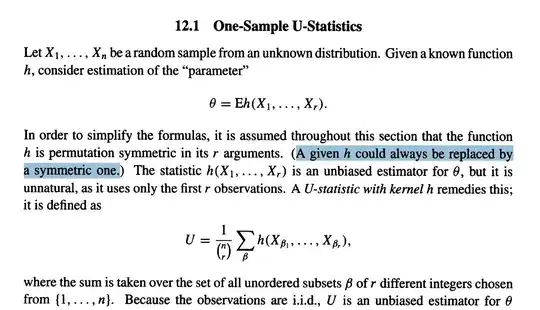I'm reading the following Chapter from van der Vaart's Asymptotic Statistics, Section 12.1 page 161 (see the screenshot below). For the $h$ function that it mentioned, I have two questions regarding its permutation symmetry:
Question 1. I don't quite understand why we could always replace an asymmetric one with a symmetric one, and how do we do it? For example, suppose my $h(X_1,X_2)=X_1^2+X_2$, how to replace it with a new symmetric function $h^*(\cdot,\cdot)$ satisfying $h^*(X_1,X_2)=h^*(X_2,X_1)$).
Question 2. Related to the first question, I feel the highlighted sentence is a bit incomplete, and I feel the complete sentence should be something like: a given $h$ could always be replaced by a symmetric one without affecting a certain property. So I 'm wondering what property it is. I have guessed the three ones for its full meaning, and I'm wondering which one is correct:
Let $U_h=\frac{1}{{n}\choose{r}}\underset{\beta}{\sum}h(X_{\beta_1},\dots,X_{\beta_r})$, and $h$ is not necessarily symmetric.
Interpretation (1). If $h$ is not symmetric, we can always replace it with a symmetric $h^*$ such that $U_{h^*}=U_{h}$, i.e., they are always numerically equal in any sample;
Interpretation (2). If $h$ is not symmetric, we can always replace it with a symmetric $h^*$ such that $U_{h^*}$ is still unbiased for $\theta$, just like $U_{h}$;
Interpretation (3). If $h$ is not symmetric, we can always replace it with a symmetric $h^*$ such that $U_{h^*}$ and $U_{h}$ are asymptotically equivalent, in the sense that they are both consistent for $\theta$ and have exactly the same limiting distribution;
Thanks!
